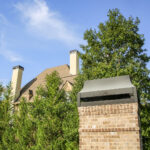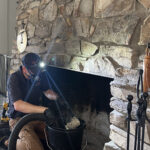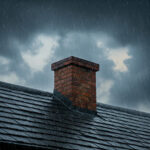10-Point Fall Chimney Checklist
 The fall season is a wonderful time of year. The weather is often just right, neither too hot nor too cold making it a great time to be outdoors enjoying the fresh air before winter sets in. But the fall season is also time to make sure the chimney is safe and ready for winter before it’s too late. Based on recent weather related events, we have learned that Mother Nature can be unpredictable and catastrophic. Follow this fall 10-point chimney checklist to make sure your fireplace is safe for use when Old Man Winter arrives.
The fall season is a wonderful time of year. The weather is often just right, neither too hot nor too cold making it a great time to be outdoors enjoying the fresh air before winter sets in. But the fall season is also time to make sure the chimney is safe and ready for winter before it’s too late. Based on recent weather related events, we have learned that Mother Nature can be unpredictable and catastrophic. Follow this fall 10-point chimney checklist to make sure your fireplace is safe for use when Old Man Winter arrives.
1. Schedule chimney cleaning and inspection
Call Chimney Solutions to schedule your annual cleaning and inspection. The Chimney Safety Institute of America (CSIA) recommends all homeowners have an annual chimney cleaning and inspection by a certified chimney sweep. Our chimney sweeps are certified by both the CSIA and National Chimney Sweep Guild. Cleaning and inspecting the chimney which includes removing flammable creosote residue and ensuring your chimney is not a safety or health hazard is the most important step in preparing your chimney for winter.
2. Chimney Cap
Now is a good time to inspect your chimney cap to ensure it is intact. A cracked or missing cap could spell trouble by allowing moisture, small animals and other debris to become lodged in the flue trapping smoke and fumes inside the chimney that could increase the risk of fire and carbon monoxide poisoning.
3. Check Flashing
The flashing is a thin metal strip that secures the chimney to the roof line. The flashing could warp, bend or become loosened allowing water and moisture inside the chimney where it could cause leaks and deterioration of the masonry.
4. Trim tree branches
Trim any tree branches away from the chimney and roof line. This will minimize the risk of fire, obstructions and chimney damage during a storm.
5. Repair missing or chipped bricks and mortar
Carefully inspect the chimney exterior. Repair chipped or missing bricks and fill gaps in mortar joints.
6. Clean the flue
An accumulation of creosote in the flue is the leading cause of chimney fires. A professional chimney sweep will carefully and thoroughly scrub the flue including the liner and walls to remove creosote, soot, and other debris and residue from the flue.
7. Remove leftover ash
Remove any left over ash from the last fire season. While a thin layer of ash is helpful in starting a fire, the moisture content from a large volume of ash will cause the fire to burn out sooner.
8. Test damper
Make sure the damper opens and closes easily and forms a tight seal when shut. Repair or replace defective dampers. Dampers that don’t close properly will allow the outside air to mix with heated air and increase your energy costs.
9. Install new batteries in smoke and carbon monoxide detectors
Carbon monoxide is an odorless and colorless gas and its effects can be lethal. Carbon monoxide poisoning commonly seeps in your home through small leaks in gas and wood-burning fireplaces and heating appliances. Replace batteries in all smoke and carbon monoxide detectors and test monthly to ensure they are in working order. Also, make sure to install carbon monoxide detectors near any room with a working fireplace.

10. Store Firewood
Purchase and store your firewood for the winter. Look for high quality dense seasoned hardwoods with low-moisture content. For best results, firewood should be stacked slightly above the ground on pallets and stored in a ventilated area protected from exposure to water or moisture.




